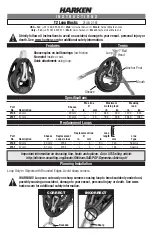
39
B.8.4
WYTRZYMAŁOŚĆ
PODŁOŻA
Przed rozłażeniem podpór sprawdź
gr
unt lub podłoże czy jest ono
odpowiednio wytrzymałe dla nacisku
wywieranego przez podpory.
Jeżeli nacisk lub ciśnienie przekracza
dopuszczalną wartość (patrzTab B-3),
zwiększ powierzchnię działania poprzez
podłożenie odpowiednich podkładek,
zapobieganie
ut
racie
stabilności
(patrz
§A.1.7).
S
prawdź czy dodatkowo
zastosowane podkładki pod nogi
odpowiednio zwiększą powierzchnię
i czy są w stanie przenieść siły
pochodzące od podpór.
Kiedy żuraw jest używany na otwartej
przestrzeni
minimalna
powierzchnia
musi być przeliczona na podstawowe
siły pochodzącej od podpór i od
ładunku. Maksymalna wielkość reakcji
na
podpory
jest
pokazana
w
załącznikach Techniczna Specyfikacja
(patrz
§D.1.1). Wartości dopuszczalnej
wytrzymałości podłoża przedstawiono w
Tab. B.3.
B.8.4 GROUND RESISTANCE
Before stabilising the machine check
that the ground or support surface is
capable of withstanding the pressure
caused by the stabilisers.
If this pressure exceeds the maximum
permitted value (see Tab B-3), increase
the area of the support surface to avoid
loss of stability (see
§A.1.7).
Check that any supplementary
sheets used to increase the area of
the stabiliser support surface are
able to support the load.
When the crane is used on open ground
the minimum support surface area can
be calculated on the basis of the
reaction of the stabilisers and the load
capacity of the ground. The maximum
reaction level on the stabilisers is shown
in the enclosure entitled Technical
Specifications (see
§D.1.1). Indicative
values for the load capacity of the
ground are shown in Tab. B.3.
B.8.4 WIDERSTAND DES
GELÄNDES
Vor der Stabilisierung der Maschine
muss überprüft werden, ob der Boden
oder jede sonstige Auflage den von den
Stützen erzeugten Druck aushalten
kann.
Wenn dieser Druck den zulässigen Wert
(siehe Tab B-3
) übersteigt, muss die
Auflagefläche vergrößert werden, um
die Gefahr eines Stabilitätsverlustes
abzuwenden (siehe
§A.1.7).
Wenn zusätzliche Platten
verwendet
werden,
um
die
Auflagefläche
der
Stützen
zu
vergrößern,
muss
sichergestellt
werden, dass diese nicht unter der
Last nachgeben.
Bei Stabilisierung auf Boden kann die
Mindestauflagefläche
anhand
der
Reaktion
der
Stützen
und
der
Tragfähigkeit des Bodens berechnet
werden: die maximale Reaktion an den
Stützen ist im Anhang Technische
Daten aufgeführt (siehe §D.1.1). Die
Richtwerte für die Tragfähigkeit sind in
Tab. B.3
aufgeführt.
Tab. B-3:
Nośność ziemi, podłoża -
Bearing capacity of the soils
- Belastbarkeit des Bodens
RODZAJ GRUNTU
SOIL TYPE
BODEN TYP
WIELKOŚĆ NOŚNOŚCI
BEARING CAPACITY
BELASTBARKEIT
[daN/cm
2
]
Luźna ziemia
Fill soil, artificially unpacked
Aufgeschütteter, nicht künstlich gestampfter Boden
od 0.0 do 1.0
from 0.0 to 1.0
von 0.0 bis 1.0
Naturalna ziemia
Natural, clearly virgin soils (mud, peat, marsh soil)
Natürliche, klar unberührte Boden (Schlamm, Torf, Sumpfboden)
0
Zwarta ziemia
Not coherent, but compact soils (fine and medium sand)
Nicht bindige, sondern feste Boden (Fein- und Mittelsand)
1.5
Piasek żwir
Coarse sand and gravel
Grober Sand und Kies
2.0
Ziemie:
Coherent soils:
Bindige Boden:
-
b. miękka -
doughy
- teigiger
0
-
miękka -
soft
- weicher
0.4
- sztywna -
rigid
- steifer
1.0
-
półstała -
half-solid
- halb-fester
2
-
stała -
solid
- fester
4
-
skała -
rock
- Gestein
15
-
stała skała -
solid rock
- massives Gestein
30
















































